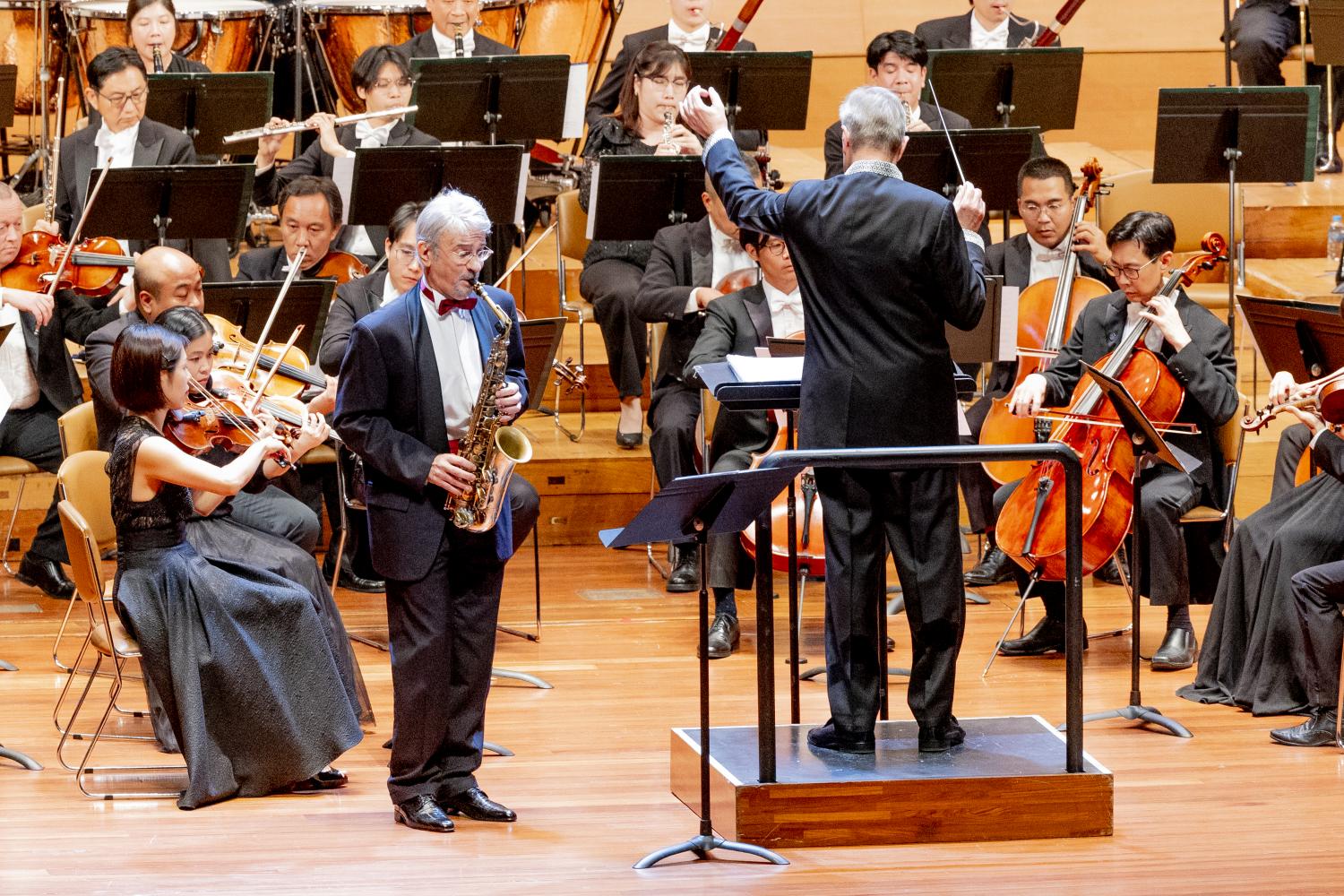A highly energised Royal Bangkok Symphony Orchestra rounded off a hugely successful 2023 concert season mid-December with a cleverly conceived and designed programme titled "Orient Et Occident", with each performance alternating between compositions by Western and Eastern composers. By now, frequent visiting English conductor Douglas Bostock certainly knows how to inspire this orchestra to the very best of its abilities, and the opening La Princesse Jaune Overture by Camille Saint-Saëns was duly performed with a delightfully assured élan. The utterly charming faux-exoticism which the composer conjures was played with innocent, abundant joy, whilst a central lush string section showed off those particular ranks in an extremely positive light.
National Artist Prof Narongrit Dhamabutra's latest grand RBSO commission then followed -- Fantasy On Chandrahu And Surindrahu for alto saxophone and orchestra -- featuring Greek soloist Theodore Kerkezos, returning here for his second visit. The renowned composer Narongrit is a 2008 Silpathorn Artist and 2021 National Artist and holds the Professor of Music Composition position at the Faculty of Fine and Applied Arts, Chulalongkorn University. He has yet again produced a beautiful new addition to his output, which is as compelling in its imaginative orchestration as it is original in its harmonic and thematic content. A silky sheen texture was evident in the string section's initial entries, with the solo saxophone making its entrance unobtrusively, yet with a coaxing charm. Episodic in nature, this work's unassumingly genial, enchanting atmosphere was a perfect match for Kerkezos' sultry timbre as the various differentiated sections unfolded.
Originally written for violin, clarinet, cello and piano in 2020, employing distinctive melodies from renowned traditional Thai pieces with Mon influence from the Ayutthaya period, the composer felt compelled to rearrange it for alto saxophone and orchestra, each section developed with new elaborations. It certainly received a lovingly presented premieré, full of poise and polish.

Alto saxophone soloist Theodore Kerkezos.
Scaramouche Suite for alto saxophone and orchestra by French composer Darius Milhaud then showcased Kerkezos in a somewhat more light-hearted mood. Heavily influenced by the culture and atmosphere of Brazil, where Milhaud had lived for an extended period, this work was originally scored for two pianist friends for pure fun and depicts the iconic clown character from the famous commedia dell'arte -- Italy's version of 16th-century slapstick. In 1941, he transcribed it for saxophone and orchestra, thus widening its appeal.
The second Thai piece of the evening than wrapped up the first half of this concert in splendid fashion -- Fantasia On A Theme Of HM King Rama IX by Dr Vanich Potavanich, since 2018 a director of Royal Bangkok Symphony Orchestra Foundation and RBSO Resident Conductor. This piece entailed a lively dialogue between the saxophone solo and the orchestra, utilising, for the most part, the motive of the exquisite royal composition Echo by His Majesty King Bhumibol Adulyadej The Great. The Fantasia ingeniously used the thematic transformation technique by keeping chord progressions in their original form. The fact that the saxophone was King Bhumibol's favourite musical instrument came across loud and clear in this taut and concise composition.
Although born in Belgium, César Franck was, from 1858 until his death in 1890, a famed resident organist at the Basilica of St Clotilde, Paris, and is indeed claimed by France as one of its foremost national figures. However, his imposing Symphony In D minor, composed between 1886 and 1888 towards the end of his life, wasn't received with any great enthusiasm at the 1989 premieré by the Paris Conservatoire Orchestra, conducted by Jules Garcin. Indeed, the initial impression on a new listener can very well be of a rather unwieldy, awkward, cumbersome entity. Whereas his great rival and colleague Saint-Saëns had actually scored the 'King of Instruments' into his Organ Symphony of 1886, Franck rather scored the conventional orchestral forces such that they themselves often resemble the sound and impression of a gargantuan church organ's stops, and therein lies the formidable challenge of this singularly unique symphony.

Conductor Douglas Bostock.
Initiated from the podium itself, then transmitting through to every single player in the orchestral ranks, everything hinges on an utterly focused, uncompromising vision and evocation of the lone organist in his isolated loft as he creates the ultimate improvisatory edifice -- ranging from the divinely ecstatic to the devastatingly demonic. It is no exaggeration to state that the tentative, hushed Lento opening utterances in the violas and lower strings must set precisely the essential tone for the symphony to have any chance of achieving an organically coherent whole. Thankfully, this was the case in this truly masterful reading by Bostock and the RBSO.
Meanwhile, the Allegretto was memorable for wonderful contributions by Kijjarin Pongkappanakrai (Cor Anglais) and Ema Mitarai (harp), whilst the Allegro ma non troppo finale was a veritable tour-de-force from all, ending in a resounding jubilation of earth-shattering intensity.

